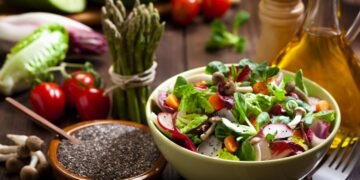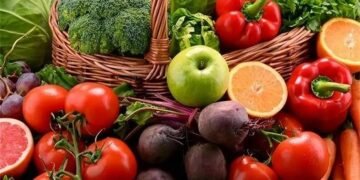Spring is the season of natural recovery, with everything thriving and fruits and vegetables entering a new growth cycle. In this season, there are many colorful and nutritious spring fruits and vegetables on the market. Reasonably utilizing these ingredients can not only increase energy and vitality, but also enhance immunity and prevent diseases. This article will explore the charm of spring fruits and vegetables, providing a comprehensive guide to healthy lifestyle, including balanced diet, nutritional supplementation, weight management, and disease prevention. We will provide a healthy diet guide, in-depth analysis of nutritious foods, the latest research in nutrition, and food safety information, and share several recipes that can help improve energy and vitality. Finally, we will provide a guide from the field to the dining table to help readers make more environmentally friendly and healthy food choices.
The Charm of Spring Fruits and Vegetables
1. Rich nutrition: Spring fruits and vegetables such as strawberries, spinach, asparagus, beets, cherries, etc. are rich in vitamin C, vitamin K, potassium, iron, and dietary fiber, which can help enhance immunity, prevent colds and other common spring diseases.
2. Antioxidant Effects: Many spring fruits and vegetables are rich in antioxidants such as vitamin E, beta carotene, and selenium, which help resist free radicals, slow down aging, and prevent chronic diseases.
3. Low calorie and high fiber: Fruits and vegetables in spring usually have lower calories, but are rich in dietary fiber, which helps control weight and promote digestion.
The contribution of a healthy lifestyle
1. Balanced diet: A balanced diet is the cornerstone of a healthy lifestyle, including sufficient protein, complex carbohydrates, healthy fats, fiber, vitamins, and minerals. Whole foods, organic ingredients, and plant-based foods are key to achieving this goal.
2. Nutritional supplementation: For certain populations, such as the elderly, pregnant women, or those with imbalanced diets, it is necessary to supplement vitamins and minerals appropriately. Suggest supplementing under the guidance of a doctor.
3. Weight management: Healthy eating habits can help control weight and reduce the risk of obesity and related diseases, such as cardiovascular disease and type 2 diabetes.
4. Disease prevention: Antioxidants and anti-inflammatory ingredients in a balanced diet can reduce the risk of chronic diseases, such as cardiovascular disease, type 2 diabetes and some cancers.
Healthy Eating Guide
1. Choose whole foods: Whole foods refer to unprocessed or minimally processed foods such as whole grains, beans, nuts, seeds, vegetables, and fruits. These foods retain more nutrients and fiber, which helps maintain health.
2. Organic Ingredients: Prioritize organic certified ingredients to ensure they are free of chemical pesticides and fertilizer residues, making them safer and healthier. Organic agriculture follows natural laws and helps protect the environment.
3. Plant based foods: Plant based foods are rich in fiber, vitamins, minerals, and antioxidants, which help improve energy and vitality and prevent diseases. For example, legumes, whole grains, and vegetables are all high-quality plant-based ingredients.
4. Seasonal Ingredients: Choosing organic ingredients of the season not only offers more affordable prices but also higher nutritional value. Understand the seasonal ingredients of different seasons and develop corresponding recipes. For example, in spring, you can choose strawberries, spinach, asparagus, beets, cherries, and so on.
Healthy recipe sharing
1. Nutritious breakfast: Strawberry spinach milkshake
Ingredients: 1 cup of organic spinach, 1 handful of organic strawberries, 1 organic banana, 1 cup of organic almond milk, 1 teaspoon of organic chia seeds, 1 teaspoon of organic honey (optional)
Preparation method: Put all the ingredients into a blender, stir evenly, and then drink.
2. Energy Snack: Cherry Walnut Energy Ball
Ingredients: 1 cup organic cherry (pitted), 1 cup organic walnut, 1/2 cup organic oats, 1/4 cup organic coconut shreds, 1 tablespoon organic honey
Preparation method: Put cherries and walnuts into a food processor and beat them into a fine powder. Add oats and shredded coconut, continue stirring until well mixed. Add honey and stir until thick. Grind the mixture into small balls and refrigerate for 1 hour before serving.
3. Healthy Lunch: Asparagus and Quinoa Salad
Ingredients: 1 cup of organic quinoa, 1 handful of organic asparagus, 1 organic red pepper, 1 organic cucumber, 1 organic tomato, 1 tablespoon of olive oil, 1 tablespoon of lemon juice, 1 teaspoon of honey, 1 teaspoon of mustard sauce, a little salt and black pepper
Preparation method: Boil the quinoa and cool it down for later use. Cut asparagus into sections, blanch in boiling water for 1 minute, remove and drain. Cut red pepper, cucumber, and tomato into cubes. Put all the ingredients into a large bowl, mix olive oil, lemon juice, honey, mustard, salt and black pepper, pour on the salad, and mix well.
4. Delicious dinner: Beetroot roasted chicken
Ingredients: 1 organic chicken breast, 1 organic beetroot, 1 organic onion, 2 cloves of organic garlic, 2 tablespoons of organic olive oil, 1 teaspoon of ginger, 1 teaspoon of rosemary, 1 teaspoon of thyme, a pinch of salt, and black pepper
Preparation method: Cut chicken breast into cubes, cut beetroot and onion into pieces, and chop garlic into small pieces. Heat olive oil in a pot, add onions and garlic and stir fry until fragrant, then add ginger and chicken breast and stir fry until color changes. Add beetroot, rosemary, and thyme, and stir fry for a few more minutes. Pour in an appropriate amount of water, bring to a boil over high heat, then simmer over low heat for 20 minutes until the chicken breast and beetroot are fully cooked. Season with salt and black pepper, ready to eat.
A guide from the fields to the dining table
1. Choose organic ingredients: Prioritize organic certified ingredients to ensure they are free of chemical pesticides and fertilizer residues, making them safer and healthier. Organic agriculture follows natural laws and helps protect the environment.
2. Local procurement: Purchase locally produced organic ingredients that are not only fresh, but also reduce carbon emissions during transportation, supporting local agriculture. By participating in local farmers’ markets or joining Community Supported Agriculture (CSA) programs, one can directly interact with farmers and learn about the sources of ingredients.
3. Seasonal Ingredients: Choosing organic ingredients of the season not only offers more affordable prices but also higher nutritional value. Understand the seasonal ingredients of different seasons and develop corresponding recipes. For example, in spring, you can choose strawberries, spinach, asparagus, beets, cherries, and so on.
4. Sustainable Procurement: Support sustainable agriculture and fair trade, choose brands and producers that prioritize environmental protection and social responsibility. Check the packaging and labels of the product to understand its production process and environmental protection measures.
5. Reduce waste: Plan your diet reasonably and avoid excessive purchases and food waste. The remaining ingredients can be made into soup or stew, fully utilizing each part. Pay attention to freshness when storing food and extend the shelf life of ingredients.
Conclusion
By understanding the charm of spring fruits and vegetables and their rich nutritional sources, we can better consume the necessary nutrients in our daily diet, improve energy and vitality, and enhance immunity. From the fields to the dining table, every step reflects care for health and the environment, allowing us to move towards a better life together. By practicing these principles of healthy eating, we can create a healthier and greener eating environment for ourselves and our families. Whether it’s breakfast, energy snacks, or healthy dinners, choosing whole foods, organic ingredients, and plant-based foods can make our lives more colorful.











































